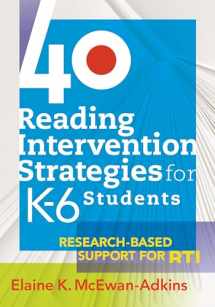
40 Reading Intervention Strategies for K-6 Students: Research-Based Support for RTI (a lesson planning resource to increase literacy levels)
Book details
Summary
Description
Finalist--Association of Educational Publishers 2010 Distinguished Achievement Award
This book provides a well-rounded collection of research-based reading intervention strategies that can be used by classroom teachers, interventionists, Title I, special educators, and ELL teachers seeking to support struggling readers in their classrooms and schools. It also provides teacher-friendly sample lesson plans and miniroutines that the classroom teacher can readily understand and adapt. Finally, the book offers citations and descriptions of current research that educators can use to substantiate their strategy choices. Most educators are deeply concerned with literacy levels in their schools. Everyone is feeling the relentless pressure of high-stakes tests and the need to provide the highest levels of instruction. Specifically, this book is intended for elementary teachers of all kinds and levels, literacy coaches, interventionists, speech pathologists, other educational specialists, special education, bilingual, and Title I administrators, and even college and university professors who are looking for a research-based collection of intervention strategies as a resource in their classrooms. The intervention strategies are numbered one to forty and are grouped into seven sections: instruction, phonemic awareness, word identification, fluency, vocabulary, comprehension, and reading a lot. Highly effective teachers often use these intervention strategies during whole-group instruction, since many of them will not only scaffold struggling readers but will also motivate and accelerate average and above-average students. Many of the interventions gain exponential power when implemented across a grade-level team or throughout the school.
Benefits
- Scaffold challenging comprehension skills like inferencing, summarizing, and monitoring.
- Teach inference with sample lessons, using authentic text examples.
- Teach more vocabulary in less time with greater understanding and retention.
- Increase the vocabulary and background knowledge of ELs and students with overall low vocabulary and language skills.
- Read historical and up-to-date research citations to inform and support your intervention decisions.
- Use the problem/solution table of contents to help you locate the precise strategy for a student s problem.
- Discover more than 30 sample lessons with step-by-step instructions and teaching formats that include modeling, ways to build in student practice, and suggestions for keeping students engaged.
- Learn routines to facilitate student practice of key reading skills.
- Adopt interventions to help students cross the fluency bridge from word identification to comprehension.
- Use the grade-level grid to help determine which strategies work best at specific grade levels.
Contents
1 Interventions for Improving Instruction
2 Interventions for Building Phonemic Awareness
3 Interventions for Building Word Identification Skills
4 Interventions for Building Fluency
5 Interventions for Building Vocabulary
6 Interventions for Facilitating Comprehension
7 Interventions for Teaching Students to Read a Lot


We would LOVE it if you could help us and other readers by reviewing the book
Book review



